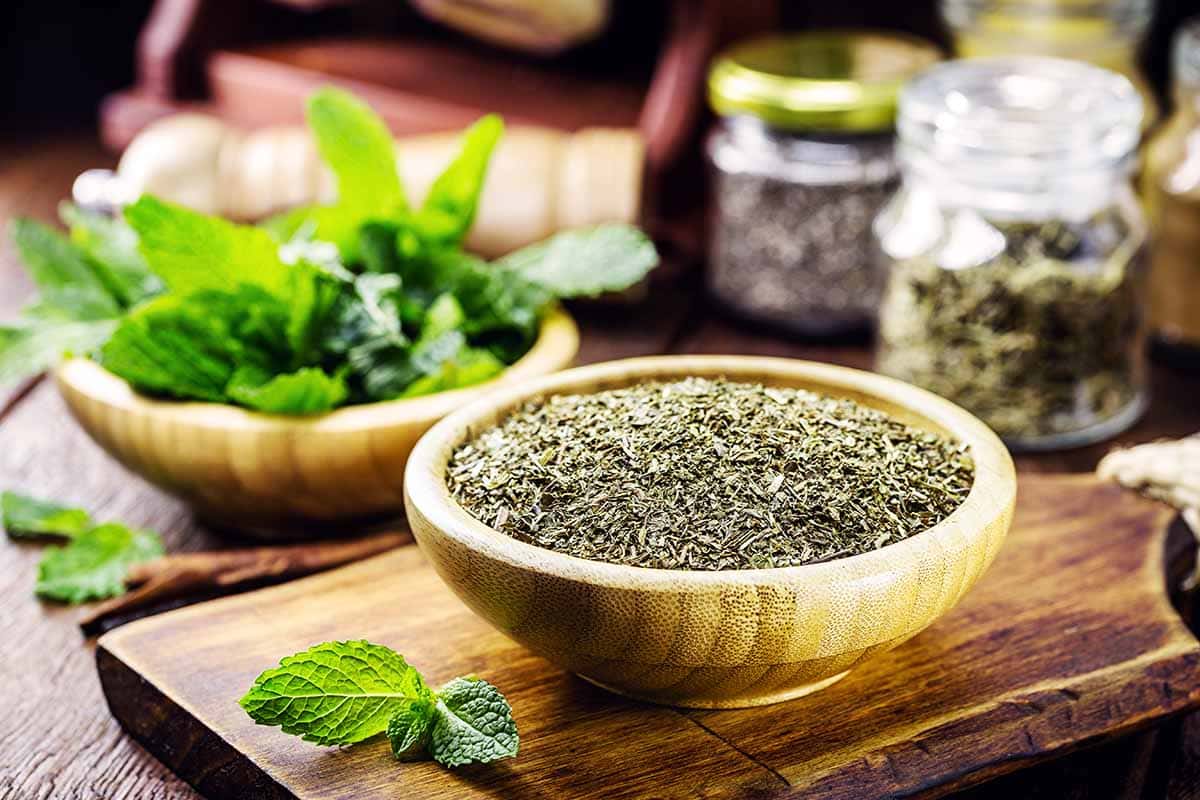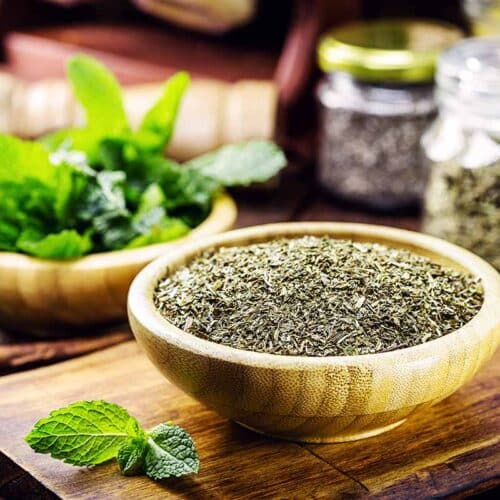What if you don’t have any marjoram or want to experiment with new flavor profiles? Fear not; in this article, we will share plenty of options for a marjoram substitute.
If you’re a Mediterranean or Middle Eastern cuisine fan, chances are you’re familiar with marjoram.
Marjoram is a fragrant herb with a slightly sweet flavor.
It is perfect for adding depth to various dishes, from hearty soups to zesty marinades.

Marjoram is a perennial herb belonging to the mint family.
It has fuzzy green leaves that form petite clusters resembling knots. For this reason, some people call this herb “knotted marjoram.”
Marjoram is native to the Mediterranean, parts of Asia, and Africa.
Ancient civilizations considered marjoram a symbol of happiness. They believed that Aphrodite, the Greek goddess of love, had grown it.
Today, the herb is still popular in Middle Eastern and Mediterranean cuisine.
Marjoram’s flavor is close to oregano; these herbs both belong to the genus Origanum.
It is earthy and woodsy, with notes of citrus and pine.
Marjoram also has a hint of bitterness but lacks oregano’s characteristic spicy taste.
People use this herb to flavor soups, stews, salads, sauces, dressings, and more.
Marjoram is also a popular ingredient in herbal teas.
There are three types: sweet marjoram, pot marjoram, and wild marjoram.
Like any other herb, marjoram can be fresh or dried.
Both kinds are useful in the kitchen.
Fresh marjoram has a more subtle flavor than dried marjoram.
For this reason, you should not cook the fresh marjoram too long if you want to maintain its bright flavor.
Dried marjoram has a more potent flavor. Adding it early in the cooking process will give you the maximum taste.
You can use fresh marjoram to substitute for dried, and vice-versa.
As dried marjoram has a stronger flavor, you would need less to replace a certain amount of fresh marjoram.
As a rule of thumb, if your recipe calls for 1 tablespoon of dried herbs, you would need 3 tablespoons of its fresh counterpart as a substitute.
Some of the most common herbs you use in cooking can easily step in for marjoram in most recipes.
If you need marjoram and don’t have any, look no further than your spice rack.
As mentioned, oregano and marjoram belong to the same plant family and share the same genus.
For this reason, oregano is the best substitute for marjoram, flavor-wise.
Oregano has similar earthy notes.
It pairs well with anything that tastes great with marjoram.
Remember, though, that there are some differences.
Marjoram is sweeter than oregano, and oregano has a more intense flavor than marjoram.
That said, you would need to make adjustments for the substitution to work.
Tips:
Some people describe the flavor of marjoram as a cross between thyme and oregano.
Because of its comparable taste, thyme is also among the best marjoram substitutes.
Thyme especially works well in stews and soups, as well as roasts.
If you’re looking for a marjoram substitute for herbal teas, look for lemon thyme.
Lemon thyme is a particular variety of thyme with a more pronounced citrus taste.
It also has less bitterness than regular thyme, making it ideal for beverages.
Tips:
If you have leftover sage from Thanksgiving, then it is time to bring it out.
After all, sage is also among the best replacements for marjoram in recipes.
Like marjoram, sage has hints of a citrus flavor that can add a nice, refreshing touch to your dishes.
Use sage in place of marjoram in seasoning poultry for the best results. For instance, use it in marinades and meat rubs for an equally savory taste.
Tips:
Summer savory is an herb that closely resembles the taste of sage.
Since sage is a great alternative to marjoram, it follows that summer savory will also do a great job here.
Summer savory has an earthy flavor, which it shares with marjoram.
That said, this herb can enhance the flavor of your meat dishes. It is especially worth trying in pork and sausage recipes.
Note that there are 2 kinds of savory: summer and winter.
Winter savory has a more intense flavor than summer savory. This flavor intensity makes it difficult to use in place of marjoram.
Tips:
Use a 1:1 ratio when substituting summer savory for fresh or dried marjoram.
Basil is a quick marjoram substitute in dishes. After all, this herb is quite popular.
You may have your own plant to harvest basil or have some in stock in your spice rack.
Basil’s milder flavor is also more palatable for many, making it a great option when feeding picky eaters.
Note that other ingredients in your dish will easily overpower the basil flavor.
That said, it will only work for some, but not all, recipes that call for marjoram.
Use it in pasta sauces and soups that need delicate instead of strong flavors.
Tips:
You can use the same amount of fresh or dried basil to replace an equal amount of dried or fresh marjoram.
Tarragon is an herb with a slightly bittersweet flavor with hints of licorice.
It is not an exact flavor match. Still, its earthy flavor will meld well with ingredients that pair with marjoram.
The licorice-like is something not present in marjoram, though.
There will be a flavor shift in your recipes.
If you love the taste of tarragon, use it to substitute fresh marjoram or dried marjoram.
It works well in chicken recipes and roasted potatoes.
Tips:
If you’re all out of herbs, reach for your trusty bottle of Italian seasoning to replace marjoram.
Italian seasoning is a spice mix that contains marjoram, after all. Not only that, but it also has oregano, basil, and thyme, all of which are great alternatives to marjoram.
Because of these ingredients, it is a quick option you can use.
Note that Italian seasoning has garlic and usually contains rosemary, too.
It has a complex flavor that is different compared to marjoram alone.
This seasoning will change the flavor of your final dish, but it is usually a good change.
Tips:
Because of its different flavor profile, starting with a 2:1 ratio of marjoram to Italian seasoning is best.
Herbs de Provence, or French Herbes de Provence, is another seasoning mix that makes a good swap for marjoram.
The traditional Herbes de Provence mix includes oregano, thyme, summer savory, and rosemary.
However, the mix is flexible, so people may add other herbs.
Some recipes for this herb mix call for fennel seeds, lavender flowers, marjoram, and basil.
Like in Italian seasoning, the ingredients here are mostly great substitutes for marjoram.
Similarly, the extra herbs here might result in a flavor shift in your recipe.
Tips:
Use half the amount your recipe calls for when substituting marjoram with Herbes de Provence.
Choosing the best substitute for marjoram can be quite challenging.
Marjoram has a unique taste and aroma, which can be difficult to replicate.
Consider the following factors to find a swap that will work wonders for your dish.
Marjoram has a slightly sweet and herbaceous taste.
That said, it’s best to choose a herb with a similar flavor profile.
Oregano is a top option since it shares the same taste. It is stronger and slightly more bitter than marjoram, though.
Thyme, basil, and savory are also good alternatives that do not stray away from marjoram’s flavor.
Different herbs have different intensity levels.
It’s important to adjust the amount you use depending on the herb.
Tarragon, for example, has a stronger taste than marjoram. Use it in smaller quantities.
Consider the other ingredients in the dish when choosing a marjoram substitute.
Some herbs may complement certain ingredients better than others.
Choosing an herb that works well with the overall flavor profile of the dish is crucial.
For instance, Herbs de Provence works best in chicken dishes. Italian seasoning, on the other hand, is perfect for red meats.
Ultimately, the best marjoram substitute will depend on your preferences.
You may not like the taste of some alternatives, so there is no reason to settle with them.
Experiment with different herbs and adjust the amount accordingly.
Oregano can substitute marjoram in most recipes due to its similar flavor profile. Both herbs belong to the mint family and share a slightly sweet, earthy taste. Other herbs you can swap with marjoram include thyme, basil, and summer savory.
Yes, you can use dried herbs to replace fresh marjoram. Do remember that dried herbs are more potent than fresh ones. You need to use a smaller amount to avoid overpowering your dish.
Marjoram goes by a few different names depending on your location. In some regions, people call it sweet marjoram to identify it from other plants in the same family. The scientific name for marjoram is Origanum majorana. For this reason, some call it a Majorana herb. In Germany, marjoram is majoran, while in France, the herb is marjolaine.
No, marjoram is not oregano. Marjoram and oregano are two different herbs. However, these herbs are closely related and share a similar flavor profile. You can use them interchangeably in some recipes as long as you know that they are not identical. Marjoram and oregano can have slightly different effects on the overall flavor of a dish.
Marjoram is an herb people widely use worldwide. However, it is most popular in Middle Eastern and Mediterranean cuisines. It is earthy, woodsy, slightly sweet, and has a hint of bitterness. If you don’t have any marjoram, there are several substitutes that you can use.
Some of the best options are dried or fresh basil, oregano, and thyme. Note that there are differences in taste, so it’s best to start with a small amount of the marjoram substitute.






